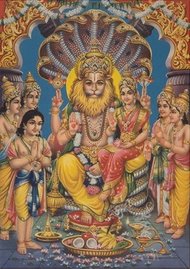
Thondanur Narasimha temple
Brief History of the place:
As we know Sri Sri Ramanujacharya, who hurriedly came out of Srirangam in Tamilnadu, settled down in Thondanur for an extended period, about 1000 years ago. From here Sri Ramanuja propagated Vishisthadwaitha Siddhantha in Karnataka. Working from Thondanur, he reinstated Sri Sri Thirunarayana temple at Melukote, which is about 10miles/15km away. After a great search for Uthsavamoorthy for Thirunarayanaswamy, Sri Yathiraja found the beautiful moorthy at Delhi with the Badshah’s daughter "BIBI". It is said that Sri Yemberumanar affectionately called the moorthy " SELVAPILLAI VAARAAI" (Selvapillai please come) and the Uthsavamoorthy started coming closer & closer to Him. This is the moorthy which we have in Melukote today.
During Sri Yathiraja’s stay at Thondanur, he answered questions from several other religious heads simultaneously from behind a curtain in the form of ADISHESHA. He is seen in ADISHESHA AVATHAR in Sri Narasimhar temple. While at Thondanur, Sri Yathiraja showed some of his powers in driving away the Evil Spirits from the daughter of King Bitti Devaraya. Impressed by his TEJAS BEARING PERSONALITY, TEACHINGS AND POWERS of Sri Ramanuja, the Hoysala King BITTI DEVARAYA, who was a Jain, got blessed by no other than Sri Yatheendra, became a Vaishnava and was given the name of " VISHNU VARDHANA".
Nambinarayana Temple at Thondanur Nov 2001
Sri Ramanuja installed "THONDAR" as a high priest of SRI NAMBINARAYANA temple at Thondanur to take care of the temple. This temple was constructed by the Hoysala dynasty and was built as a prototype to the Belur Chennakesava temple and is over 1000 years old. Large artistic pillars inside the temple resemble the pillars seen in the Belur temple. Sri Nambinarayana is in Samasrayana position with Shankam in the right hand (instead of left hand as normal) and Chakram in the left hand (instead of right hand as normal).
Yemberumanar is responsible for the beautiful lake at Thondanur. It is said that the water has never dried since it was created. There are small man-made waterfalls and canals, making it a great water sport attraction particularly for the kids. The water is so clear that the king Tippu Sultan called it "MOTI TALAB ", as one could see the PEARL fallen from his broken necklace in the clear waters
Yes Thondanur means immediately you can go to flash back mode to our Udayavar's era and time. A Shivate king Koluthunga Chola was ruling the South at that time. He was a staunch Shivate. He had an evil Minster named Nalluran. He did not like our Vaishnavism growing, so he poisoned the ears of the King and told him that he should take it in writing from all the Religious head that Shiva is greatest of all. Particularly he did not like our Udayavar's and Our Vaishtaadwaithams growth. Then some how news reached Udayavar's camp that kings men are coming take him to Kings court. Sensing trouble Our Koorath Alwan convinces Ramanujacharya to undertake Pilgrimage. Saying this Koorath Alwan and our Ramanujacharya exchanged their clothes. Then Kings man took away Koorath Alwan and rest is history. Meanwhile our Udayavar traveled along the river Cauvery's course and ultimately reached Thondanur in Melnadu ( Present day Karnataka ) One of the Pradhana Shishiya named Thondanur Nambi his disciple was happy to play host to his beloved Acharya . But problem was lot of disciple had also come along with Our beloved Acharya , Nambi was not rich. Then knowing this our Acharya Valal Sent word to Katalaivari and Kongupratti and they donated 1000 Gold coins, with this daily Bhagavath Aradhanam and Thadi Aradhanam was held nicely. At that time Hoysala was ruled by Bitti Deva and he was a follower of Jainism. Once Nambi went to Palace and found it was gloomy. Then he asked Raja what is the problem. For that he told his daughter is processed by Brahmarakshas and even my Jain Guru's could not do anything. For that Nambi told My guru is here and he will cure. For that Bitti Deva told if that miracle happens he will become the followers of Udayavar. Then Udayavar went to palace, he was welcomed by the King and queen Then the princess came and did act of mad woman. Then Ramujar Sprinkled the Holy water from his kamandalam. Then she fainted and when she regained consciousness , she was turned a new leaf. Such is the mahima of our Udayavar. Then seeing this King and queen bowed to our Acharya and asked him to accept as disciples, Our Acharya accepted them and He did a Namakranam to King as Vishnuvardhan.( In memory of this great event, the king built five Vaishnava temples Channiga Narayana temple at Belur, Nambi Narayana temple at Thondanur, Keerthi Narayana temple at Talakad, Veera Narayana temple at Gadag and Chelva Narayana temple at Melkote. These temples are lasting monuments of Karnataka culture and architecture. Ramanuja built many other temples too in Thondanur).
Then seeing this Jain Acharyas told Ramanuja has done some Vasiyam and they wanted to have a debate. Then 12000 Jains debated with our Udayavar, Then Our Ramanuja asked his disciple to put a screen and he took a form a 1000 headed Adhisheshan and defeated this Jains. ( even today you will find the Statue of Udayavar in Nambi Narayana temple and also Narasimha Temple. Here there are three temples, they are Nambi Narayana Temple. ( It is one the Pancha Narayana KSHéTRAM established by Bhagavath Ramanuja. the Moolavar is 18 feet height and he is holding Shanku and Chakra in reverse order ( We could not take picture as it is under Archeological Survey of India , May be in near future you can see the Picture) . it is said he did Pancha Samasakara to Thondanur Nambi, then a Narasimha Temple and Gopala Krishna Temple. Then near by you can see a vast big lake which was built by our Udayavar with his own hand.





